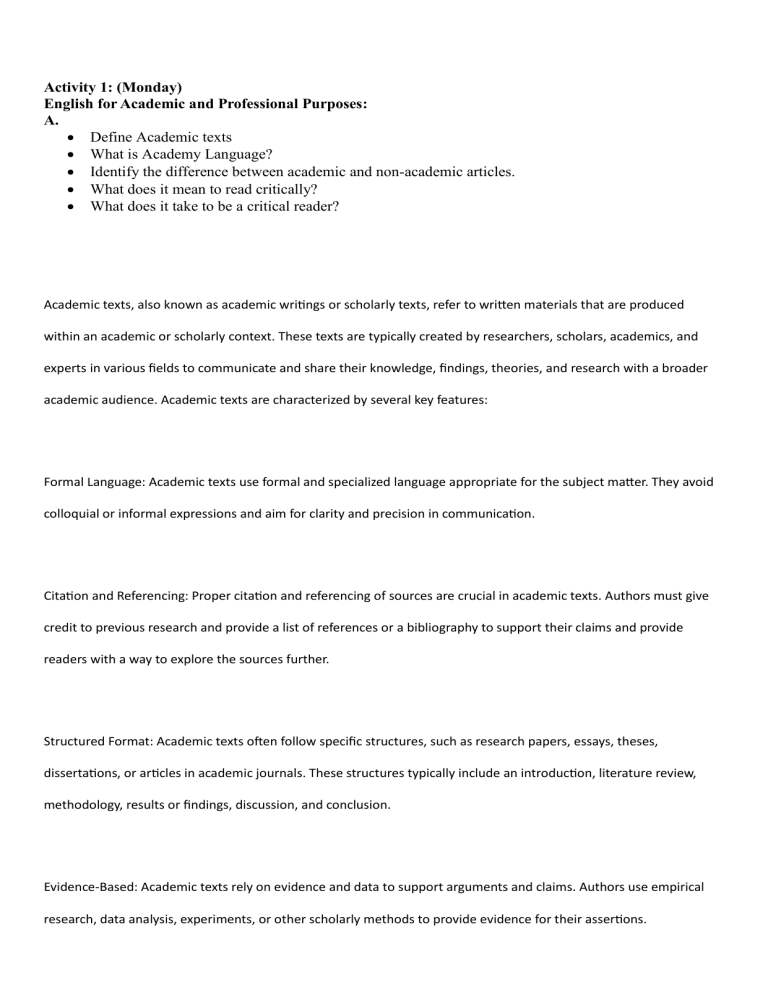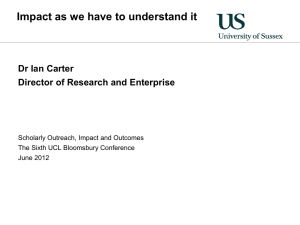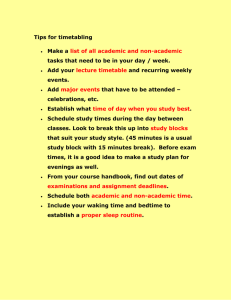
Activity 1: (Monday) English for Academic and Professional Purposes: A. Define Academic texts What is Academy Language? Identify the difference between academic and non-academic articles. What does it mean to read critically? What does it take to be a critical reader? Academic texts, also known as academic writings or scholarly texts, refer to written materials that are produced within an academic or scholarly context. These texts are typically created by researchers, scholars, academics, and experts in various fields to communicate and share their knowledge, findings, theories, and research with a broader academic audience. Academic texts are characterized by several key features: Formal Language: Academic texts use formal and specialized language appropriate for the subject matter. They avoid colloquial or informal expressions and aim for clarity and precision in communication. Citation and Referencing: Proper citation and referencing of sources are crucial in academic texts. Authors must give credit to previous research and provide a list of references or a bibliography to support their claims and provide readers with a way to explore the sources further. Structured Format: Academic texts often follow specific structures, such as research papers, essays, theses, dissertations, or articles in academic journals. These structures typically include an introduction, literature review, methodology, results or findings, discussion, and conclusion. Evidence-Based: Academic texts rely on evidence and data to support arguments and claims. Authors use empirical research, data analysis, experiments, or other scholarly methods to provide evidence for their assertions. Objective Tone: Authors of academic texts strive for objectivity in their writing. They avoid emotional language and personal opinions and instead present information and analysis in a balanced and impartial manner. Peer Review: Many academic texts undergo a peer-review process before publication. In this process, experts in the field evaluate the quality and validity of the work, helping to ensure its accuracy and reliability. Advanced Vocabulary: Academic texts often employ specialized terminology and vocabulary specific to the field of study. This vocabulary is used to precisely convey complex concepts and ideas. Cohesiveness and Logic: Academic texts are expected to be logically structured, with clear connections between ideas. Authors use transitional phrases and well-organized paragraphs to guide readers through their arguments. Examples of academic texts include research papers, scholarly articles, academic books, conference papers, theses, and dissertations. These texts serve as essential resources for the academic community, contributing to the dissemination of knowledge, the advancement of research, and the development of expertise in various fields of study. You sent "Academic language," also referred to as "academic discourse" or "academic writing," is a specific form of language used primarily within the context of academic or scholarly communication. It is the language style and conventions that scholars, researchers, and students use when writing and speaking about academic subjects and topics. Academic language is characterized by several key features: Formal and Objective Tone: Academic language is typically formal and objective. It avoids colloquial or informal expressions and maintains a neutral, impartial tone. Personal opinions and emotions are minimized in favor of evidence-based reasoning. Precise and Technical Vocabulary: Academic language often incorporates specialized terminology and vocabulary specific to a particular field of study. This precise terminology helps convey complex concepts accurately. Complex Sentence Structures: Academic writing often includes complex sentence structures with subordinate clauses and a variety of punctuation marks. These structures are used to convey intricate ideas and relationships. Citation and Referencing: Academic language requires proper citation and referencing of sources. Citations and references are used to acknowledge the work of others and provide evidence to support arguments and claims. Clarity and Transparency: Despite its complexity, academic language aims for clarity and transparency. Authors strive to make their ideas and arguments accessible to an educated audience by presenting information in an organized and logical manner. Evidence-Based Reasoning: Academic writing relies heavily on evidence and data to support arguments and claims. Authors are expected to use research, empirical data, analysis, and examples to substantiate their points. Structured Organization: Academic texts typically follow specific structures, such as introductions, literature reviews, methodologies, results, discussions, and conclusions. This structured organization helps readers navigate the content. Critical Thinking and Analysis: Academic language encourages critical thinking and analysis. Authors are expected to evaluate existing research, identify gaps in knowledge, and contribute original insights to their field. Third-Person Point of View: Academic writing often employs the third-person point of view (e.g., "The study found...") rather than the first-person point of view (e.g., "I found..."). This contributes to the objective tone of academic language. Cohesion and Coherence: Academic writing strives for cohesion and coherence through the use of transitional phrases, topic sentences, and clear connections between ideas. Academic language varies somewhat across disciplines and academic fields due to the specific conventions and requirements of each field. However, the overall goal is to communicate scholarly knowledge, research findings, and academic arguments effectively within the academic community. Mastery of academic language is essential for academic success, as it enables individuals to contribute to and engage in scholarly discourse. You sent Academic and non-academic articles differ in several key aspects, including their purpose, audience, content, style, and sources. Here are some of the main differences between the two: 1. Purpose: Academic Articles: These articles are primarily written to contribute new knowledge, research findings, or scholarly insights to a specific academic field or discipline. Their purpose is to inform, educate, and advance the understanding of a particular subject among experts in the field. Non-Academic Articles: Non-academic articles serve a variety of purposes, such as informing, entertaining, persuading, or providing practical information to a general or non-specialized audience. They may be written for magazines, newspapers, blogs, websites, or other media outlets. 2. Audience: Academic Articles: The primary audience for academic articles includes scholars, researchers, students, and professionals within a specific academic discipline. These articles assume a high level of prior knowledge about the subject matter. Non-Academic Articles: Non-academic articles are intended for a broader readership that may not have specialized knowledge in the topic. They are written to be accessible and engaging for the general public. 3. Content: Academic Articles: Academic articles are characterized by their depth and rigor. They often include detailed research methodologies, data analysis, literature reviews, citations of scholarly sources, and discussions of theoretical frameworks. They contribute new research or scholarship to the field. Non-Academic Articles: Non-academic articles may cover a wide range of topics and vary in depth. They are more likely to include anecdotes, personal experiences, and practical advice. While they may reference sources, the focus is on conveying information to a general audience. 4. Style: Academic Articles: Academic writing is formal, objective, and often uses specialized terminology and vocabulary. It maintains a scholarly tone and avoids emotional or informal language. Non-Academic Articles: Non-academic writing can be more conversational and engaging. It may use a less formal tone and style, allowing for creativity and storytelling, depending on the publication and its audience. 5. Sources: Academic Articles: Academic articles rely heavily on peer-reviewed journals, academic books, and reputable scholarly sources for citations. Authors are expected to provide thorough references to support their claims. Non-Academic Articles: Non-academic articles may reference a variety of sources, including news articles, books, websites, personal interviews, and firsthand experiences. The emphasis is on conveying information rather than exhaustive citation. 6. Length: Academic Articles: Academic articles can be lengthy, ranging from several pages to dozens of pages, depending on the publication and field. They accommodate in-depth analysis and discussion. Non-Academic Articles: Non-academic articles tend to be shorter and more concise. They aim to deliver information or insights in a format that suits the preferences of a general audience. These differences highlight the contrasting goals and characteristics of academic and non-academic articles, making it essential to adapt writing style and content to the intended audience and purpose of the publication. You sent To read critically means to engage with a text in a thoughtful, analytical, and evaluative manner. It involves going beyond simply absorbing information and instead actively questioning, analyzing, and assessing the content of the text. Critical reading is a skill that allows you to understand, interpret, and engage with written material in a more profound and discerning way. Here are some key aspects of critical reading: Questioning: Critical readers ask questions about the text as they read. They inquire about the author's purpose, the main arguments or claims, the evidence presented, and the reliability of the sources. They also consider the implications and consequences of the information presented. Analyzing Arguments: Critical readers evaluate the strength and validity of the arguments presented in the text. They assess whether the evidence provided is convincing, whether there are logical fallacies, and whether there is bias or omission of important information. Contextualizing: Critical readers consider the broader context in which the text was written. This includes understanding the author's background, the historical and cultural context, and any relevant social or political factors that might influence the text's content and perspective. Identifying Assumptions: Critical readers seek out underlying assumptions in the text. They recognize that authors often make assumptions that may not be explicitly stated, and they evaluate the impact of these assumptions on the text's credibility. Evaluating Evidence: Critical readers assess the quality and relevance of the evidence and sources cited in the text. They look for reliable and authoritative sources and evaluate whether the evidence supports the author's claims effectively. Comparing and Contrasting: Critical readers may compare the text they are reading with other texts on the same topic. This helps them gain a broader perspective and evaluate the uniqueness or contribution of the text in question. Recognizing Bias and Perspective: Critical readers are alert to potential bias in the text. They consider the author's point of view, possible ideological or cultural biases, and the potential impact of bias on the presentation of information. Making Inferences: Critical readers draw logical inferences from the text's content. They use the information provided to form their own conclusions and opinions while being mindful of the limitations of the text. Reflecting and Synthesizing: Critical readers reflect on the text's overall message and significance. They synthesize the information and ideas presented, considering how they relate to their own knowledge and experiences. Engaging in Discussion: Critical reading often leads to discussion and dialogue. Readers may share their insights, interpretations, and critiques with others to further refine their understanding. Critical reading is a valuable skill in academia, as it enables students and scholars to engage with research papers, books, and other scholarly materials in a meaningful way. It also plays a crucial role in everyday life by helping individuals evaluate news articles, advertisements, and other forms of written communication to make informed decisions and opinions.



